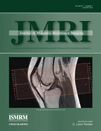Clinical evaluation of automated scan prescription of knee MR images
Abstract
Purpose
To compare an automated scan planning method to manual scan positioning in routine knee magnetic resonance imaging (MRI) studies.
Materials and Methods
The automated scan planning method uses anatomical landmarks in a 3D survey of the knee. The method is trained by example plannings, consisting of manual slice positioning by an experienced technologist in 15 MRI studies. Automated knee MR examinations obtained in three geometries in 50 consecutive patients were compared to those obtained in 50 consecutive control patients, where imaging planes were planned manually. Anatomical coverage and slice angulation were scored for each geometry on a 4-grade scale by an experienced radiologist blinded to the way of planning; groups were compared using a Mann–Whitney U-test.
Results
In 150 automated sequences the technologist adapted slice positioning in four cases (addition of slices to adapt to the size of the knee), representing the only automated sequences that received a poor rating. Thirteen sequences with manual planning received a poor rating. No difference in quality was found (P > 0.05) between automated and manual plannings for coronal coverage, sagittal coverage and angulation, and transverse angulation. Rating of automated planning was higher for transverse coverage, but lower than manual planning for coronal angulation.
Conclusion
Automated sequence prescription for knee MRI is feasible in clinical practice, with similar quality as manual positioning. J. Magn. Reson. Imaging 2009;29:141–145. © 2008 Wiley-Liss, Inc.




